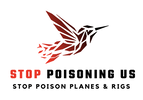The IssuePassive Chemical Exposure from Spray Drift
Each autumn, cotton growers send Poison Planes up into the air, to defoliate their cotton crops with highly toxic chemicals. Poisoned evergreen trees, such as Peppercorn and Kurrajong trees, loose their leaves. Even in perfect flying conditions, the toxic chemicals end up on other growing fields, roofs and even towns. This is called 'spray drift' and is a major problem. Peppercorn and Kurrajong trees are the 'Canaries in the Cotton Fields'. Spray drift and overspray affect not only trees, but also agricultural crops and animals. Humans suffer from chronic disease from Passive Chemical Exposure.
|
What'S HAPPENING, AND WHAT ARE THE IMPACTS?
Passive Chemical Exposure from Spray Drift and Overspray
Tree damage occurs in cotton growing areas during annual defoliation. This is known as 'overspray' and 'spray drift' or 'chemical spray drift'.
Every autumn, in cotton growing areas, trees and other plants show defoliation damage. The vegetation clearly shows that synthetic chemicals are landing throughout communities and on food and water production areas.
The effects are clearly correlated to cotton growing areas and correspond to the annual cotton defoliation activities.
Even in perfect flying flying conditions, winds can change quickly and blow chemicals onto neighbouring farms.
Over 20 species of trees and shrubs have been affected with the most visible including:
Our food chain is at risk, with livestock grazing areas covered with overspray.
Rainwater that many rural people rely on is exposed to overspray.
The health of farming communities are put at risk by persistent and cumulative exposure.
Wind blows... and overspray does not stop at the fence.
Water falls... and runoff does not stop in the field. It continues its journey through the Murray Darling system.
The whole of landscape is affected.
Regulation is lax.
Expertise is lacking.
Action is lagging.
Farmers are afraid to speak up.
Imagine living with this industry next door.
The health of our trees is the best indicator for the health of our community.
Passive Chemical Exposure from Spray Draft and Overspray is getting worse every year. It's time to get responsible policy in place.
Subscribe to help stop the poison planes.
Every autumn, in cotton growing areas, trees and other plants show defoliation damage. The vegetation clearly shows that synthetic chemicals are landing throughout communities and on food and water production areas.
The effects are clearly correlated to cotton growing areas and correspond to the annual cotton defoliation activities.
Even in perfect flying flying conditions, winds can change quickly and blow chemicals onto neighbouring farms.
Over 20 species of trees and shrubs have been affected with the most visible including:
- Peppercorn
- Kurrajong
- Rosewood
Our food chain is at risk, with livestock grazing areas covered with overspray.
Rainwater that many rural people rely on is exposed to overspray.
The health of farming communities are put at risk by persistent and cumulative exposure.
Wind blows... and overspray does not stop at the fence.
Water falls... and runoff does not stop in the field. It continues its journey through the Murray Darling system.
The whole of landscape is affected.
Regulation is lax.
Expertise is lacking.
Action is lagging.
Farmers are afraid to speak up.
Imagine living with this industry next door.
The health of our trees is the best indicator for the health of our community.
Passive Chemical Exposure from Spray Draft and Overspray is getting worse every year. It's time to get responsible policy in place.
Subscribe to help stop the poison planes.
THE THREAT OF PESTICIDE SPRAY DRIFT
A Community Information and Action Kit
Read ‘THE THREAT OF PESTICIDE SPRAY DRIFT - A Community Information and Action Kit’, by Jo Immig, National Toxics Network, 2009
AUSTRALIAN PESTICIDES MAP
Spray Drift Events
